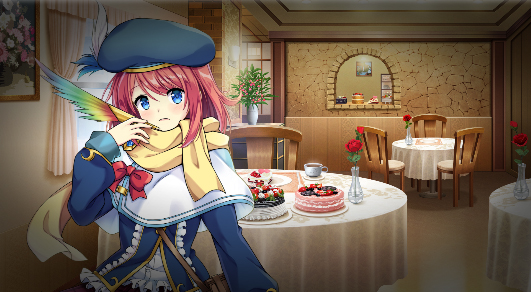File - Choose a mask file to apply to the screen.
Vague - Apply smoothing on the mask edges. Here is a comparison with Vague values 0 (minimum) and 255 (maximum).


Duration - Determines the speed of the transition.
Screen
The Screen commands allows you to manipulate and add effects to the game screen.
Applies an effect to the screen.
Type - The effect that will be applied to the screen.
Wobble makes the scene move in irregular and staggering motion.
Power sets the intensity of the wobble. It makes the wobble effect more visible the higher it is.
Speed sets the speed of the wobble. The higher it is, the faster it is.
Orientation - Sets the wobble direction.
Vertical sets the wobble direction to the vertical direction.
Horizontal sets the wobble direction to the horizontal direction
Both sets the wobble direction to both directions.
Duration sets how long, in milliseconds, the effect will take place.
Blur makes the scene appear unclear.
Power sets the intensity of the blur, the higher the value, the more blurry the screen will become.
Duration sets how much time, in milliseconds, it takes until the screen reaches the specified blur-power. Use this to smoothly blur-in or blur-out the scene.
Pixelate makes the scene appear pixelated/blocky.
Width sets the width of a single block/pixel.
Height sets the height of a single block/pixel.
Duration sets how much time, in milliseconds, it takes until the pixelation reaches the specified block/pixel-size. Use this to smoothly pixelate the scene.
Z-Order sets the Z-Level at which the effect will take place. By default, the effect will only influence non-ui game objects such as the background, characters, etc. but not the message-box or message text. You can change the Z-Order to only affect the background or to affect the entire screen including message box.
Easing applies tweening to the effect animation. More information can be seen in Easing Effects page.
Changes the overall screen color. This does not affect logs, message window and pictures.
Tone Control - Controls the screen color. Adjust the color tone (-255 to 255) for Red, Green, and Blue.
Use Grey to set the intensity (0 to 255) of the grayscale filter. The higher the value, the greater the overall strength of the color.
Normal, Dark, Sepia, Morning and Night buttons at the bottom of the dialog box are to quickly apply the standard values for the tones represented by their respective names.
The Normal button reverts to the original color tone. You can check color tone changes in the preview area on the top side of the dialog box.
Duration - Determines how long the screen effect will take place.
Continue will make the scene immediately continue.
Wait will make the scene wait until the exit animation is done.
Fills the entire screen with the specified color for an instant, and then gradually reverts to the original color. This allows you to represent a flash of lightning, etc.
Color Control - Controls the flash color. Use the Red, Green, and Blue slider bars (0 to 255) to specify the color to flash.
You can check the color you specified in the preview area on the top side of the dialog box. Use Power to specify the color's opacity (0 to 255).
Setting Power to "0" makes the color completely transparent, rendering it invisible on screen.
Duration - Determines how long the flash effect will take place.
Continue will make the scene immediately continue.
Wait will make the scene wait until the exit animation is done.
Shakes the screen, useful for scenes depicting shock or impact.
Range X - Set the horizontal movement of the screen. It randomizes between the negative and positive of the value you set.
For example, if you put 5, it will shake the screen from -5 to 5.
Range Y - Set the vertical movement of the screen. It randomizes between the negative and positive of the value you set.
For example, if you put 5, it will shake the screen from -5 to 5.
Duration - Determines how long the shaking will last.
Continue will make the scene immediately continue.
Wait will make the scene wait until the exit animation is done.
Easing applies tweening to the shake movement. More information can be seen in Easing Effects page.
Moves the screen, useful for in-game camera movements.
X - The amount of pixels to move on x-axis.
Y - The amount of pixels to move on y-axis.
Duration - The duration of the movement.
Continue will make the scene immediately continue.
Wait will make the scene wait until the movement is done.
Zooms the screen, useful for in-game camera effects.
Zoom X - The zoom on x-axis.
Zoom Y - The zoom on y-axis.
Duration - Determines how much time the zoom will take.
Continue will make the scene immediately continue.
Wait will make the scene wait until the zoom is done.
Rotates the screen, useful for in-game camera effects.
Direction - The rotation direction, can be Clockwise or Counterclockwise.
Speed - The rotation speed. The higher the value, the faster the rotation.
Duration - Determines how long the rotation-animation will take place.
Continue will make the scene immediately continue.
Wait will make the scene wait until the rotation is done.
Stops all commands from initiating. The screen stays frozen until you call [Screen Transition].
This command changes how the Scene will appear.
File - Choose a mask file to apply to the screen.
Vague - Apply smoothing on the mask edges. Here is a comparison with Vague values 0 (minimum) and 255 (maximum).


Duration - Determines the speed of the transition.